Mohenjo-Daro : A 4000 Years Old but Modern City
Hello friends, here I bring a post about a mysterious city that existed on earth more than 4000 years ago. It was rediscovered in the early decades of 20th century. The city had some modern features that the cities of our times have, which is a very surprising. Let us visit to know more about it.

Mohenjo-Daro which means Mound of Dead in Sindhi was the most sophisticated urban center of Indus Valley Civilization( also known as Meluhan Civilization). The original name of the city is still unknown. The name Mohenjo Daro of the city was given locally by the Sindhis. It was built around 2500 BC contemporary to the civilizations of Egypt and Mesopotamia. It is now located in the Larkana district of Sindh province of Pakistan on west of the river Indus. As evident from the name, on the bank of this river Indus Valley Civilization had flourished. Planned with modern-like urban features Mohenjo-Daro was a symbol of excellence of the civil engineering of Indus Valley Civilization. It was declared a UNESCO World Heritage Site in 1980.
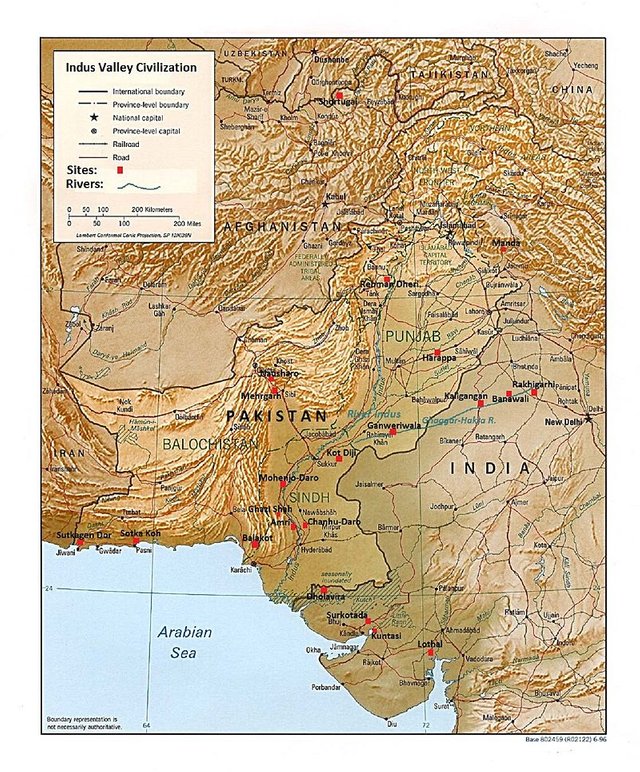
Mohenjo-Daro was the largest city of the Indus Valley Civilization along with some other major urban areas at Harappa, Dholavira, Lothal and few others. It spanned from Pakistan to North India extending westwards to Iranian border, south to Gujarat in India and northwards to Bactria. Indus Valley Civilization started to decline and Mohenjo-Daro was abandoned around 1900 BC due to some mysterious reason. Some archaeologists believe that a heavy flood was the reason while some others believe the reason to be drought.
The remains of the city were rediscovered 3700 years after it was abandoned, by an Indian archaeologist R. D. Banerji who visited the site for finding a Buddhist Stupa which was known to be there. He found a small stone scraper there which caught his attention and convinced him of the site’s antiquity. After this discovery large scale excavation of the site was undertaken by Kashinath Narayan Dikshit in 1924–25, and John Marshall in 1925–26 and the city of Mohenjo-Daro came into light. It spread a strong wave of surprise and shock to the western historians who repudiated the ancientness of Asian Civilization.
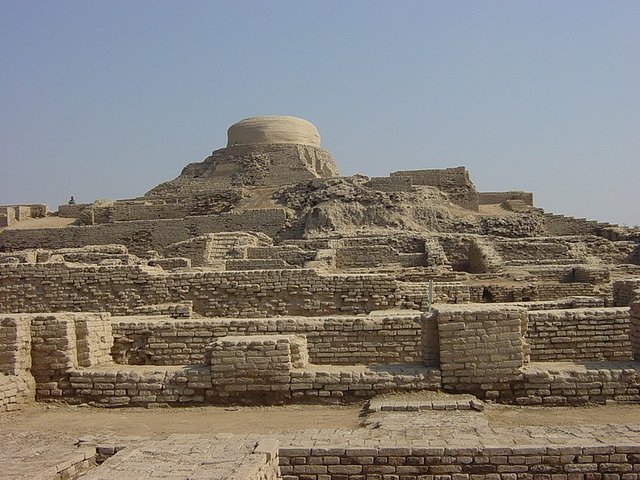
After this, a series of excavations were carried out on the site until 1965 when excavations were banned due to serious weathering damages caused by the excavations. Only minor excavations and some surveys were allowed. A dry core drilling done by Pakistan’s National Fund for Mohenjo-Daro in 1915 which revealed that the city is much larger than the excavated area.
What is Special about Mohenjo-Daro ?
Mohenjo-Daro is an example of Excellence of Urban Planning, Civil Engineering and cultural greatness which we believe to be the features of modern society. The city dwellers were used to some modern-day-like practices.
City Planning
Mohenjo-Daro makes everyone wonder by its city structure with rectilinear roads and residential blocks along arteries crossed at right angles. The cities structure along with the public buildings and facilities tells a story of a very organized civil society.
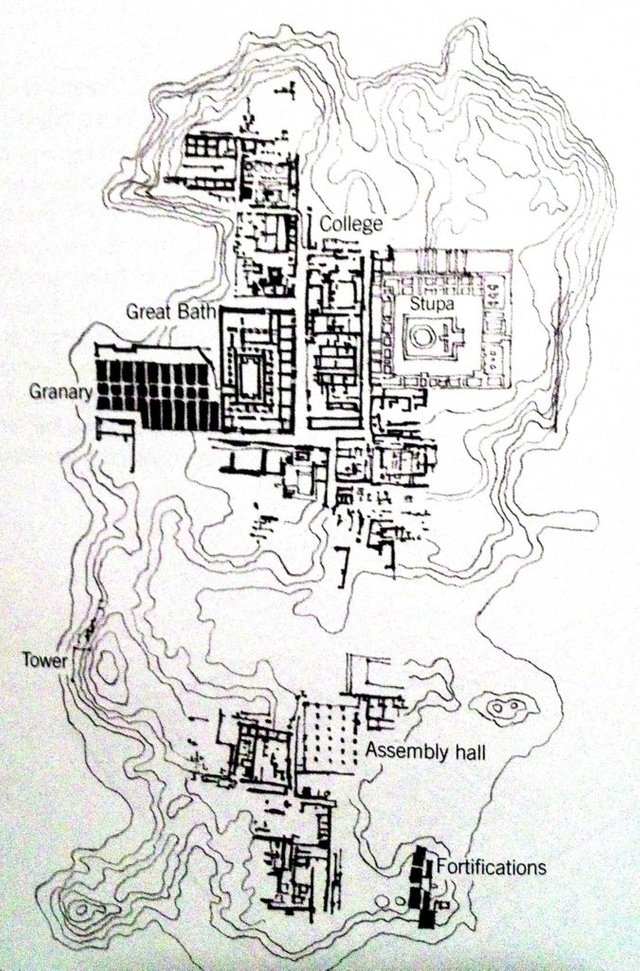
Main Features of the City :
- The buildings were made of mortared bricks, mud bricks and some wooden superstructures.
- The major streets were more than 9 metres wide.
- The more surprising fact about the city is that it had a very sophisticated and complex water management and drainage system. Such water and sewage management systems were also found in other cities of Indus valley like Dholavira and few more others.
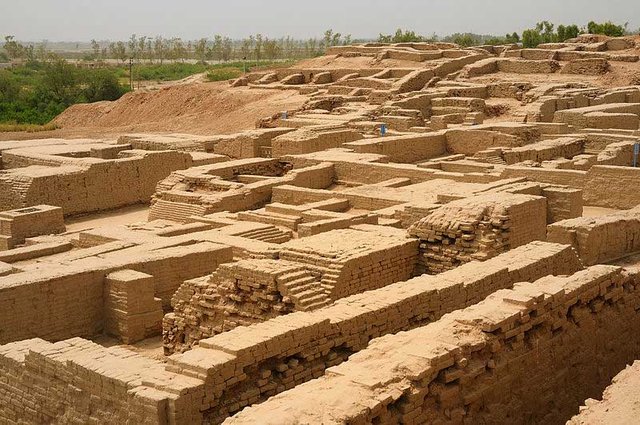
- It had public toilets and in the residential areas every house had a tiled bathroom with a deep well.
- Sewers connected throughout the city drained the waste water.
- Gutters and water collectors were dug in the main streets in cul-de-sacs. In the smaller streets waste water were drained through some bottomless jars.
- At some crossroads there were brick containers used as waste disposal.
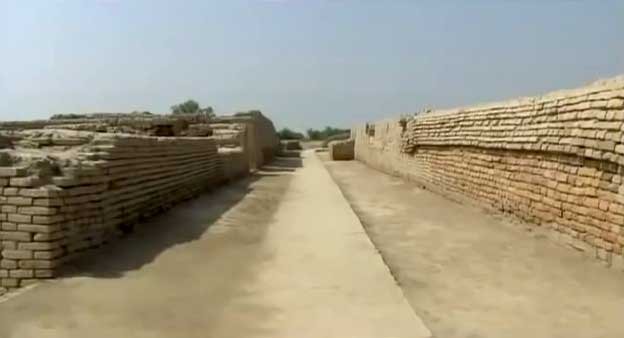
- Great Granary : A large building with several wall divisions was discovered in the city which was used as a granary. There were several air ducts in the rooms which might have been used to dry-up the grains. Some archaeologists believe that carts would have brought grains from the outside the city and put them directly into the granary.
- The Great Bath : The most spectacular work of the builders of Mohenjo-daro was the Great Bath which is called the earliest public water tank of the ancient world. It is believed that the bath had religious importance and was used for religious purification.
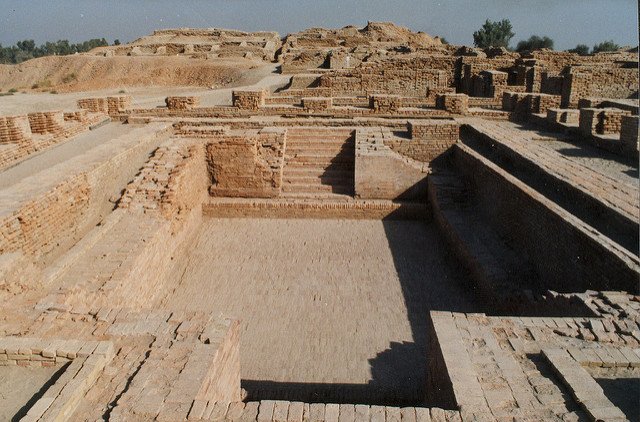
The structure is 12 metres in length, 7 metres wide and 2.4 metres in depth. Two wide staircases in north and south were used as the entry to the pool. One hole was found at one end of the structure which might have been used to drain water to the bath. The floor and sidewalls were made watertight with bricks plastered with some material. A thick layer of bitumen was laid on the floor as well as on the sidewalls to make it even more watertight. Along the eastern edge there were some room and in one room there was a well believed to be used to drain some water to the drain. It is believed that rainwater was also drained to fill the pool but no such inlet was found in the structure.
- College of Priests : Near the bath there was a large pillared buildings with 78 rooms and three verandas. Two staircases led to the upper floors and the roof top. The building is believed to be the residence of priests and has been named as College of Priests.
- Mohenjo-Daro had no city walls but some guard towers for fortification purpose. The fortification structure and city layout of Mohenjo-Daro resembles the other city centers of the Indus-Valley like Harappa. For this reason it is believed that the city was an administrative center.
Flood Protection and Water Conservation :
The people of Mohenjo-daro had expertised the technique of flood water control and to use the river water for agricultural and city needs. The structures with dams and reservoirs found on the outskirts of the city speaks of a very sophisticated river water control and conservation system. The dwellers of the city had converted a problem to their advantage. A river Ghagar-Hakra which has Indian mythological reference is believed to have flown near the site . The river changed its course due to earthquakes and the river dried up. The riverbed was found near the site and the water of the river present underground was also found.
Whenever there was flood, the flood defense structure protected the city from it and collected the flood water in large reservoirs which was used for the city and for agriculture. A more sophisticated water management system was found at the site of Dholavira.
Artifacts Found at the Site :
Numerous artifacts which includes some seated and standing statues, toys, copper and stone tools, carved seals, balance scales and weighs, gold and jasper ornaments were found during the excavation which are now conserved at some museums in India, Pakistan and England. Some special among them are:
The Dancing Girl
A bronze statue of a girl which has been named as, The Dancing Girl was found at the site in 1926. The statue is 10.5 centimeters high.
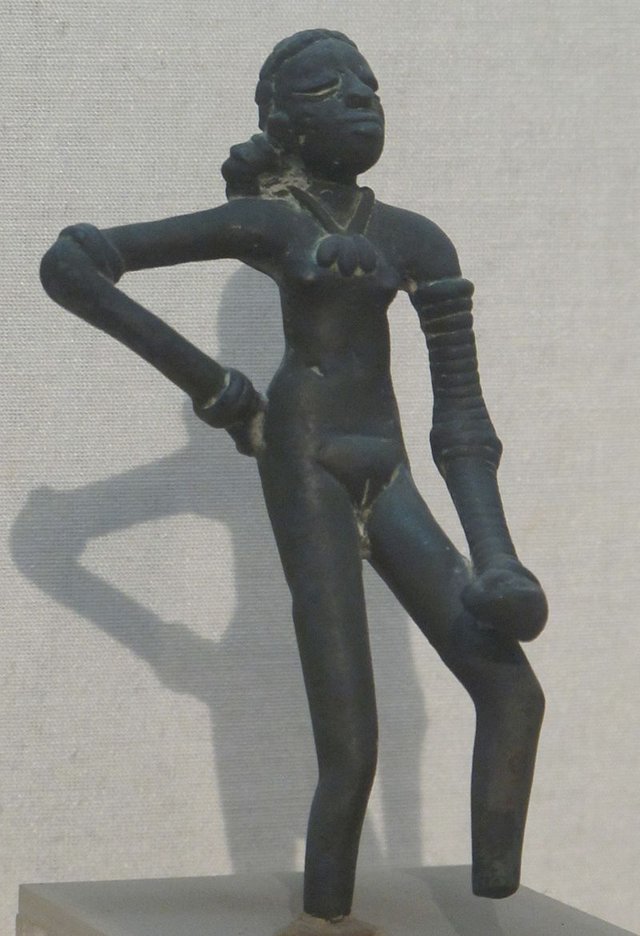
Many archaeologists makes different opinions about the statue based on her posture and ornaments. British archaeologist Mortimer Wheeler described the item as his favorite statuette and said :
“She's about fifteen years old I should think, not more, but she stands there with bangles all the way up her arm and nothing else on. A girl perfectly, for the moment, perfectly confident of herself and the world. There's nothing like her, I think, in the world."
It is not sure that she was a dancer but her posture with one hand on her hips, knees bent forward makes the impression that she was confident on what she was doing and was good at it. This statue tells a lot about the Indus-Valley civilization :
- They had mastered metal bending, casting and other methods which deals with ore.
- The people of the civilization practiced entertainment and specifically dance was a part of the culture.
The Priest King :
During the excavation in 1927 a stone statue 17.5 centimeters high with some ornamental brick designs inside a wall concavity was found.

It was a statue of a neatly bearded man with hairs combed back. With earlobes pierced and a fillet around his head he wore armband and a cloak with design of trefoil leaf, single circle as well as double circle motifs with traces of red. Though there is no evidence that priests or monarchs ruled Mohenjo-Daro the archaeologists named the statue as The Priest King.
The Seal
A seal with a design of seated cross legged three headed man surrounded by some animals, engraved on it was found in the site. Some people describe it is a Yogi and they believe that Yoga may be originated from here. Some others call it Pashupati(lord of animals).
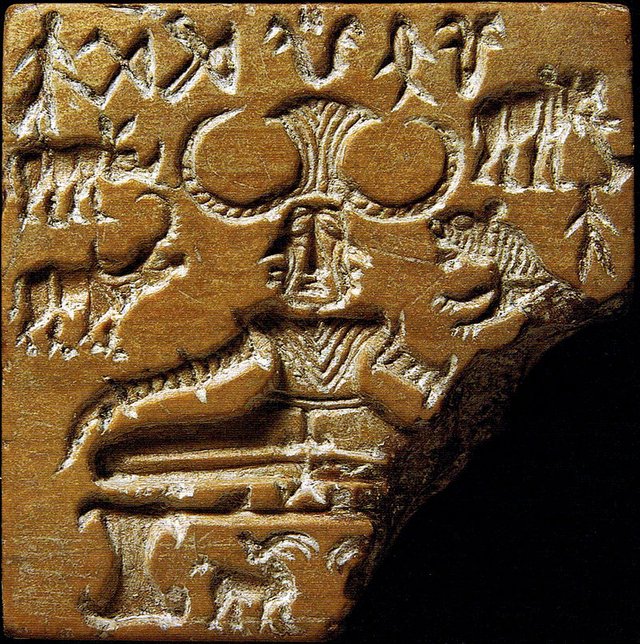
Seven Stranded Necklace
A necklace with an S-shaped clasp having seven strands each of 4 feet long, was found at the site. It had metal-bronze bead-like nuggets which connected each arm of the S in filigree. There are about 1600 nuggets in it and it weighs approximately 250 grams. It is now in an Indian private conservation.
Connection with Mesopotamia
Severeal seals on which figures of various animals like the mysterious unicorn, cow, rhino, tiger etc. were engraved, were found at Mohenjo-daro and other sites of Indus Valley. Similar kinds of seals were discovered at some sites in Sumer, Mesopotamia which tells of a trade link between the two civilizations.
Archaeologists believe that Indus Valley ships sailed to the Mesopotamia and the nearby countries through some sea-link in the Arabian sea. The similarities found in the artifacts in the different sites in these countries implies to it. Some interpreters were used to translate the languages between these different culture. The readers are advised to read about the trade relations between these civilizations from various sources in the internet.

Thousand cities of this kind were scattered in an area twice the size of entire France across the Indus Valley. The other cities were discovered later in time. Who lived in these cities is still unknown. However, the city is an evidence that a very sophisticated and technically developed civil society lived in the city. It is believed that Indus-Valley is where the Indian culture had its ancestry.
References :
- Official Website of Mohenjo Daro
- Official Website of Harappa
- Ancient Civilizations
- Mysteries of Mohenjo-Daro by Youtube Channel : Ancient-Astronaut Arguments
- In Search of Meluhha: The Story of Mohenjodaro
- Wikipedia
I hope you enjoyed learning about Mohenjo Daro. If you love dreaming and learning new things then please follow me, @physics-o-mania and motivate me to bring some more interesting information-rich contents.
Don't Forget to Read My Previous Articles :
- Mining The Lunar Surface : A New Race in Space
- The ITER Project: Future of Endless Clean Energy?
- ISRO : The New Glamor in Space Race
- The Quest for the Grand Unification : The Theory of Everything
- Why Does it Happen?
- The Hunt for the Dark Matter : The Unseen Neighbor
- Quantum Computers : A Threat to Bitcoin
- The Strange Face of Reality : The Quantum Realm
- Einsteinian Revolution
- Teleportation : The Ultimate Revolution in Transportation
If you are interested in various domains of science and mathematics then join the @steemstem project, team to support high quality STEM(Science,Technology, Engineering and Mathematics) related contents. Join them in steemit.chat to interact with the science authors from all over the world.
Thank you for reading my content!!

Dancing girl looks like she's judging me from across the bar
Haha...may be
Congratulations @physics-o-mania! You have completed some achievement on Steemit and have been rewarded with new badge(s) :
Click on any badge to view your own Board of Honor on SteemitBoard.
For more information about SteemitBoard, click here
If you no longer want to receive notifications, reply to this comment with the word
STOPThis was an excellent historical piece. Thanks for sharing it!
The use of bitumen to seal the public bath caught my eye. It was a recurring source of toxic chemicals in the ancient world, namely, polycyclic aromatic hydrocarbons (PAHs). There was a televised program recently (I think it was on NOVA) that examined the use of bitumen by a prehistoric California Channel Island population, since they used bitumen as a type of plastic to create water jugs. If you're interested, there's more on the subject here: https://ehjournal.biomedcentral.com/articles/10.1186/s12940-017-0261-1. I know it's not directly on point, but I would be curious if the Mohenjo-Daro residents were exposed to PAHs during the manufacture of bitumen-related products, perhaps as an airborne health problem.
They must have been exposed...from both sources : manufacturing and in water storage in the pool. I seems they din't know the water which they were using for religeous purification was actually harming them slowly. Thanks for sharing. Following you...keep in touch.
Thanks, man. I'm following you too now.
But I heard the term "California Indians" first time...whom does it refer. does it have anything related to India?
Indeed. The first time I had heard of them was from the NOVA TV program. But I don't believe there is any connection at all to the nation-state India. It's just the long standing historical blunder referring to all indigenous people in North America as "Indians."
Great post, i takes many exclusive knowledge from this post, i am just following u...........
Awwww i love your posts m following uuuuuu
Thnk you...
youre welcome :)
youre welcome :)
nice article :-)
an ancient city building is more beautiful than today one .
Veo tu post interensante seguire leyendo
Mesopotamia... The oldest and highly civilized. Love it. These documentaries make me so curious. Nazca lines. Pyramids. How... We wonder how the heck they built these. But i suppose these folks would probably ask us how we make smartphones ... Fair enough hahah
I want to time travel there
It would be nice to see :) hehe
It would be nice to see :) hehe
Terrific write up. Content and the images used were extraordinary. Keep up the good work.